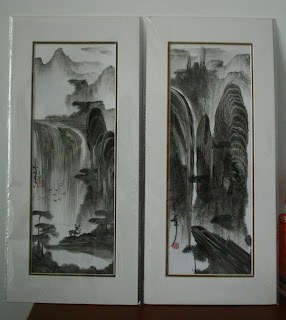(The Yu Yuan bazaar begins.)
I 
The attraction is mainly the Yu Garden of the Ming Dynasty, a show piece of a classical Chinese garden, but I have definitely seen far superior ones in
There is a popular tea house in the middle of a man-made lake, called Mid-Lake Pavilion Teahouse and yes, I can guess that it is only popular with tourists as it charges 50 yuan for a person for tea.
(Micro-inscription of a Buddhist scripture on a piece of stone. One can see the patterns of the stone under strong lighting.)
Yu Yuan Bazaar
But I must admit that I am attracted to the Yu Yuan bazaar which is just next to the garden. It is a modern building of Chinese architecture and is a concentration of stalls that sell things from souvenirs to traditional Chinese products. Sieving through the labyrinths of souvenir stalls, one can still find a lot of genuinely art pieces at the bazaar.
There is a huge number of tea shops selling tea leaves to tea sets and tea pots and you can get to sample the tea first before actually buying. You can find Chinese paintings and equipment as well, not to mention some Chinese musical instruments. There is also a proper tea house just across the road before the bazaar starts.
Folk Arts
The most interesting section is the area where the stalls of folk arts are and it is really an eye-opener to different forms of art. It is a real pity that these stalls are all located in one tiny corner of the bazaar and people are selling their art forms in an unappreciated manner, in my opinion.
(Ink painting on a leaf with a poem from Zheng Banqiao (Qing Dynasty) that praises the strength of bamboos that allows them to thrive in the harshest conditions.)
We come across a stall of leaf painting where one paints directly onto the veins of a leaf. The stall next door is a man who specializes on micro carving on stones. He could inscribe a full length Chinese poem or lyrics onto a piece of stone that one can only read the inscriptions under the help of a macro lens. There is also a stall that can weave leaves into any life-like creatures.
I am most fascinated by a stall showcasing traditional ink paintings of classical Chinese mountainous sceneries. I am drawn in by the fact that one can almost feel the different texture of the mountains, the rocks and the flowing water in the paintings. And all these are actually “painted” by either palm or fingers. If I haven’t seen the lady demonstrating right before our eyes, I will never have guessed that from the look of the paintings that all these are painted by alternative methods.
These are arts! But why can they only be treated like dirt cheap “folk arts”? One needs equally the aesthetical vision to compose and a certain level of technique to produce such a mesmerizing effect as much as oil paintings or sculptures. There must be a better way of preserving, 
(Palm or finger painting.)


